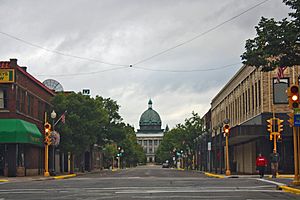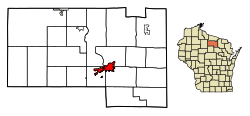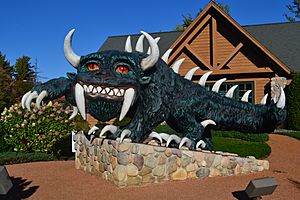Rhinelander, Wisconsin facts for kids
Quick facts for kids
Rhinelander, Wisconsin
|
|
|---|---|

Looking east at downtown Rhinelander with view of the Oneida County Courthouse dome
|
|

Location of Rhinelander in Oneida County, Wisconsin
|
|
| Country | United States |
| State | |
| County | Oneida |
| Area | |
| • Total | 8.68 sq mi (22.47 km2) |
| • Land | 8.42 sq mi (21.82 km2) |
| • Water | 0.25 sq mi (0.65 km2) |
| Elevation | 1,549 ft (472 m) |
| Population
(2020)
|
|
| • Total | 8,285 |
| • Density | 983.6/sq mi (379.8/km2) |
| Time zone | UTC−6 (Central (CST)) |
| • Summer (DST) | UTC−5 (CDT) |
| Zip Code |
54501
|
| Area code(s) | 715 & 534 |
| FIPS code | 55-67200 |
| GNIS feature ID | 1572231 |
Rhinelander is a city in Wisconsin, United States. It is the main city, also called the county seat, of Oneida County. In 2020, about 8,285 people lived there.
Contents
History of Rhinelander
The area where Rhinelander now stands was first called Pelican Rapids. This name came from the fast-moving water where the Wisconsin and Pelican Rivers meet. Around 1870, Anderson W. Brown and Anson P. Vaughn explored the area. They saw great pine forests and thought it would be a good place for a lumber mill.
Anderson Brown's brother, Webster Brown, who later became Rhinelander's first mayor, helped make this dream come true. They convinced their father and uncle to buy the land. They planned to build a town there.
How Rhinelander Got Its Name
The city was named Rhinelander after Frederic W. Rhinelander. He was the president of a railroad company called the Milwaukee, Lake Shore and Western Railway. The Brown brothers wanted the railroad to build a line to their new town. This would help their lumber business grow.
After many years of talks, the Brown family agreed to give half their land to the railroad. In return, the railroad built a line to the city in 1882. This helped Rhinelander become an important business center in the region.
Geography and Climate
Rhinelander is located in Wisconsin. The city covers about 8.61 square miles (22.3 square kilometers). Most of this area is land, with a small part covered by water.
Rhinelander's Climate
Rhinelander has a climate with warm summers and cold winters. This type of climate is called a humid continental climate. Winters can be very cold due to Arctic air. Summers are usually cooler, partly because of the influence from Lake Superior and Lake Michigan. The city gets a good amount of rain and snow throughout the year.
Population Information
| Historical population | |||
|---|---|---|---|
| Census | Pop. | %± | |
| 1890 | 2,658 | — | |
| 1900 | 4,998 | 88.0% | |
| 1910 | 5,637 | 12.8% | |
| 1920 | 6,654 | 18.0% | |
| 1930 | 8,019 | 20.5% | |
| 1940 | 8,501 | 6.0% | |
| 1950 | 8,774 | 3.2% | |
| 1960 | 8,790 | 0.2% | |
| 1970 | 8,218 | −6.5% | |
| 1980 | 7,873 | −4.2% | |
| 1990 | 7,427 | −5.7% | |
| 2000 | 7,735 | 4.1% | |
| 2010 | 7,798 | 0.8% | |
| 2020 | 8,285 | 6.2% | |
| U.S. Decennial Census | |||
2020 Census Details
In 2020, Rhinelander had 8,285 people living there. For every square mile, there were about 983.6 people. Most of the people living in Rhinelander were White (90.8%). There were also people from other backgrounds, including Native American, Black or African American, and Asian. About 2.5% of the population was Hispanic or Latino.
2010 Census Details
In 2010, the city's population was 7,798. There were 3,545 homes in Rhinelander. About 26.9% of these homes had children under 18 living in them. The average age of people in the city was 40 years old.
Economy and Tourism
Rhinelander is an important center for business, industry, and fun activities in the Northwoods area of Wisconsin. Because of its many forests, lakes, and trails, it's a popular place for vacations in both summer and winter. The city has a paper mill and a hospital.
Fun Things to Do in Rhinelander
The Rhinelander area offers many vacation activities. You can go fishing, boating, canoeing, kayaking, or ride ATVs. There are also trails for mountain biking, hiking, and snowmobiling. In winter, people enjoy cross-country skiing and snowshoeing. Bird watching and golfing are also popular.
Rhinelander is a great place for shopping and finding places to stay. A popular spot in summer is the Pioneer Park Historical Complex. It's open from Memorial Day to Labor Day. You can explore many interactive exhibits about Rhinelander's interesting history.
Arts and Culture
Rhinelander is famous for the hodag. This is a green and white creature from local folklore. People say it lives in the woods nearby. The hodag is the mascot for the city and for Rhinelander High School. It's also the mascot for Northwoods Community Secondary School.
- The Rhinelander Flea Market happens every Wednesday. It is held by the ice arena between Labor Day and Memorial Day.
- An arts and cultural center is located in the old Federal Building downtown.
- Rhinelander hosts the Hodag Country Festival, a big country music event.
- Other events include the Northwoods Pride Festival and the Oneida County Fair.
- Oktoberfest is also celebrated in Rhinelander.
- Sirencon is an event held at Tesomas Scout Camp. People who like sirens gather here from all over the world.
Museums to Visit
- ArtStart Art Museum
- CCC (Civilian Conservation Corps) Museum
- Logging Museum
- Rhinelander Historical Society Museum
- Rhinelander School Museum
Parks and Recreation
- Hodag Park
- Pioneer Park
- Shepard Park
- West Side Park
Golf Courses
- Northwood Golf Course
- Rhinelander Country Club
Education
- The Rhinelander School District serves students in the area.
- Zion Lutheran School is a Christian school for Pre-K through 8th grade. It belongs to the Wisconsin Evangelical Lutheran Synod.
- Nativity of our Lord Catholic School is a Pre-K through 8th grade school. It is part of the Diocese of Superior.
- The Lake Julia campus of Nicolet Area Technical College is just outside Rhinelander.
- The University of Wisconsin used to have a summer program called School of the Arts at Rhinelander. It ran for 52 years and ended in 2015.
Media
Rhinelander is home to WJFW-TV, an NBC television station. This station also serves the Wausau area. Other stations from Wausau, like WSAW-TV (CBS) and WAOW (ABC), also reach Rhinelander. WXPR is a public radio station at 91.7 FM. It is based in Rhinelander.
Transportation
Major Highways
| U.S. 8 goes east towards Crandon, Wisconsin. To the west, US 8 leads to Prentice, Wisconsin. | |
| WIS 17 goes north to Eagle River, Wisconsin and south to Merrill, Wisconsin. This road is on the east side of Rhinelander. | |
| WIS 47 runs north to Woodruff, Wisconsin and south to Antigo, Wisconsin. |
Rhinelander-Oneida County Airport
The Rhinelander-Oneida County Airport (KRHI) serves Rhinelander and nearby communities. It offers both regular flights and services for smaller planes. The airport is two miles west of the city. It has a long concrete runway and a shorter asphalt runway.
Notable People from Rhinelander
- Deming Bronson, a brave soldier who received the Medal of Honor
- Webster E. Brown, a U.S. Representative
- Elizabeth Burmaster, a former leader of Wisconsin's public schools
- Jason Doering, a former professional football player for the Indianapolis Colts and New York Giants
- Darrell Einertson, an MLB baseball player
- Dan Forsman, a professional golfer who won five PGA Tour events
- Clarence W. Gilley, a Wisconsin State Representative
- Kathryn Givney, an actress in plays and movies
- Rita Gross, a writer and teacher who grew up near Rhinelander
- John Heisman, the person for whom college football's Heisman Trophy is named; he is buried in Rhinelander
- Walt Kichefski, an NFL football player
- John Kotz, a basketball player who was named Most Outstanding Player in the 1941 NCAA Tournament
- Craig Ludwig, a former professional hockey player
- Neil McEachin, a Wisconsin State Representative and judge
- Bernard N. Moran, a Wisconsin State Senator
- Alvin E. O'Konski, a U.S. Representative
- T. V. Olsen, an author
- Parker Retzlaff, a NASCAR driver
- Arthur M. Rogers, a Wisconsin State Representative
- Richard J. Saykally, a chemistry professor at the University of California, Berkeley
- Justin O. Schmidt, an entomologist known for his "sting pain index"
- Vanessa Semrow, who was Miss Wisconsin Teen USA and Miss Teen USA 2002
- Joan Valerie, a film actress
- John C. Van Hollen, a Wisconsin politician
- Robert Vito, a television journalist
- Dale Wasserman, a playwright
- Mike Webster, a member of the Pro Football Hall of Fame
- Jean M. Wilkowski, a diplomat
Images for kids
See also
 In Spanish: Rhinelander para niños
In Spanish: Rhinelander para niños









